Amur Leopard
Panthera pardus orientalis
The Amur leopard may be the rarest big cat on Earth!
Advertisement
Amur Leopard Scientific Classification
- Kingdom
- Animalia
- Phylum
- Chordata
- Class
- Mammalia
- Order
- Carnivora
- Family
- Felidae
- Genus
- Panthera
- Scientific Name
- Panthera pardus orientalis
Read our Complete Guide to Classification of Animals.
Amur Leopard Conservation Status
Amur Leopard Facts
- Prey
- Deer, Cattle, hares, small mammals
- Estimated Population Size
- 103 as of 2018
- Biggest Threat
- Poaching and habitat loss
- Gestation Period
- 90-105 days
- Habitat
- Forests
- Predators
- Human poaching and competition with Siberian tigers
- Diet
- Carnivore
- Average Litter Size
- 2-3 cubs
- Lifestyle
- Solitary
- Common Name
- Amur leopard
- Location
- Russia's Far East
- Slogan
- The Amur leopard may be the rarest big cat on Earth!
- Group
- Mammal
View all of the Amur Leopard images!
“The Amur Leopard may be the rarest big cat on Earth”
The Amur leopard is an isolated subspecies of leopards surviving along the border of Russia and China. While the Amur leopard may be the rarest big cat on Earth, its numbers have been rebounding thanks to incredible conservation efforts.
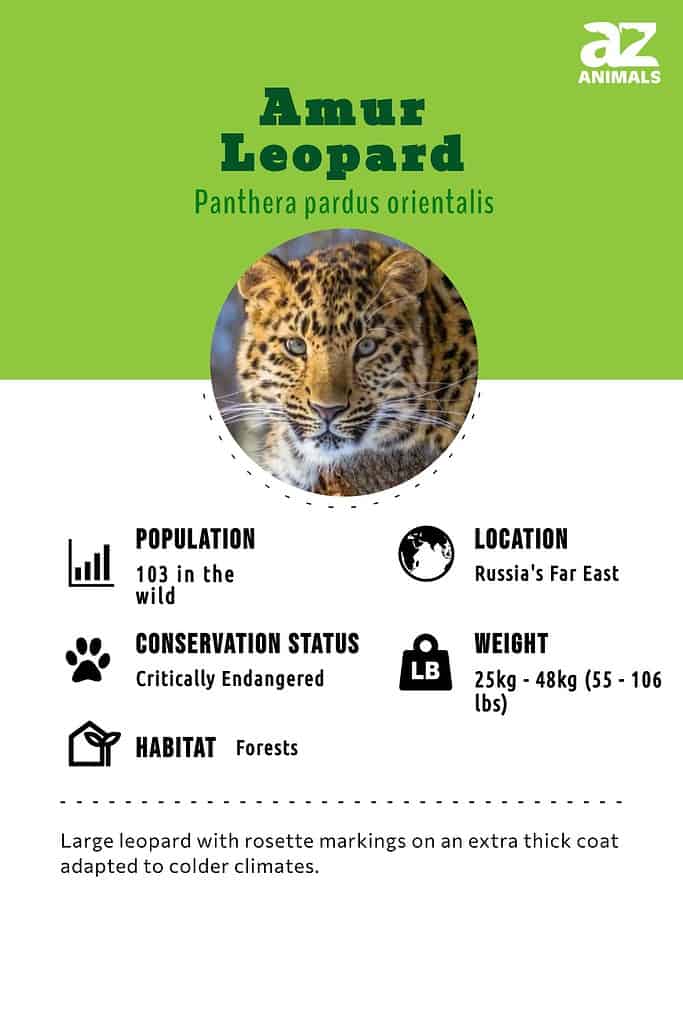
Incredible Amur Leopard Facts
- The Amur leopard lives in extreme environments in Russia’s far east and has unique adaptations like a coat that grows significantly during the winter season to protect it against harsh conditions that can reach below -30 degrees Celsius!
- In 2000, a survey found just 30 Amur leopards in a small area along the border of Russia and China, making the Amur leopard the rarest big cat on Earth.
- Thanks to conservation efforts, today the Amur leopard’s population is estimated to have increased to more than 100 individuals in the wild, and more than 300 in zoos across the world.
Ready for more Amur leopard facts? Make sure to read ‘10 Incredible Amur Leopard Facts!‘
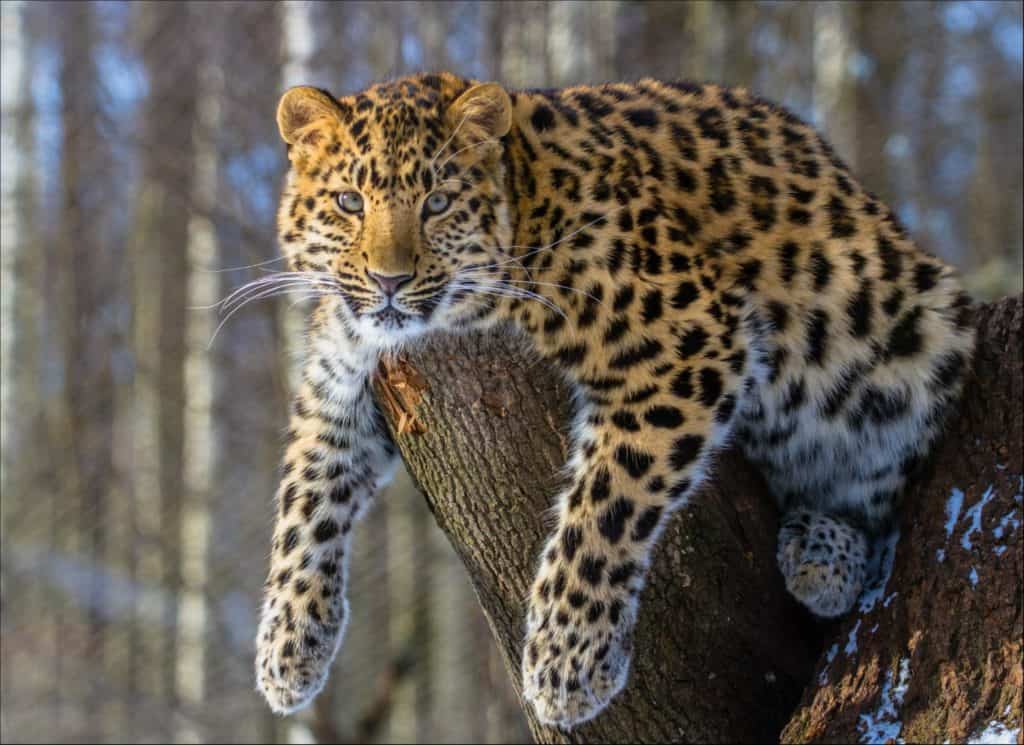
Amur leopards are critically endangered and the rarest big cat on earth.
©Dmitri Gomon/Shutterstock.com
Scientific Name
The scientific name for the Amur leopard is Panthera pardus orientalis. The genus Panthera covers big cats ranging from tigers to lions, to jaguars and leopards. Pardus originates from Greek and means ‘spotted,’ while orientalis relates to the geography Amur leopards inhabit, having been first described in Korea.
Evolution
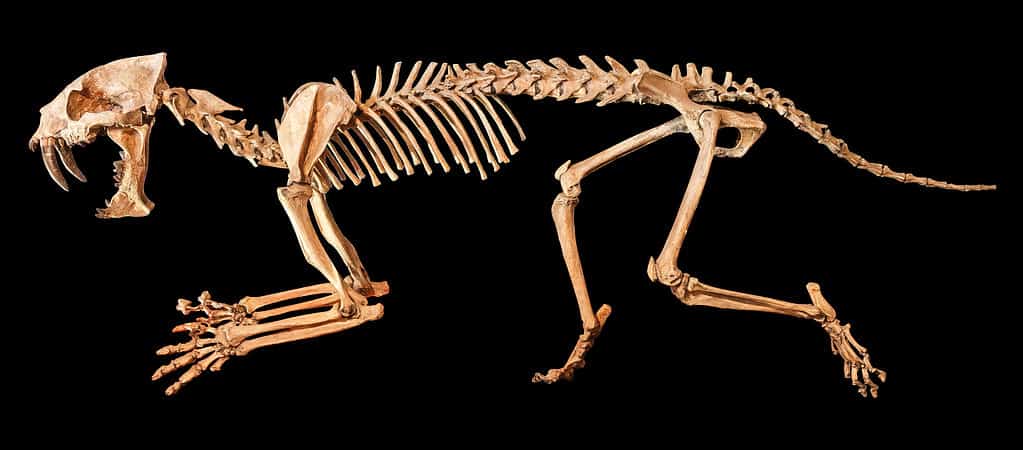
The Saber-tooth cat was an Ice Age ancestor of the leopard.
©Puwadol Jaturawutthichai/Shutterstock.com
Miacids were primitive animals that were on one of the first rungs of the evolutionary ladder for many animals living on the earth today. Miacids existed 62-63 million years ago and gave rise to cats, bears, dogs, skunks, mongooses, and hyenas. Miacids dwelled in Eurasia and North America and passed on the predatory trait of hunting to their ancestors.
The Proailurus came from the group of Miacids known as Viverravidae which led to the evolution of cats. Traits of the animal that are still present in cats are binocular vision, similar dental structure, fur, tail, and a meat diet. Fossils of Proailurus have been found in Europe and Asia.
Pseudaelurus appeared next, approximately 20 million years ago. It originated in Eurasia and was the first cat to reach North America. This cat’s fur had rosettes like a leopard’s.
The Smilodon, or saber-tooth cat, came along next and was one of the largest cats ever to have lived. This ancestor of the leopard became extinct during the Ice Age during the Pleistocene Epoch, around 10,000 BC. Homotherium is another ancient feline found in North America until around 10,000 years ago.
Amur leopards are decent from a 19th-century northeastern Asian leopard subspecies that ranged over southeastern Russia, Korea, and northeastern China.
Appearance
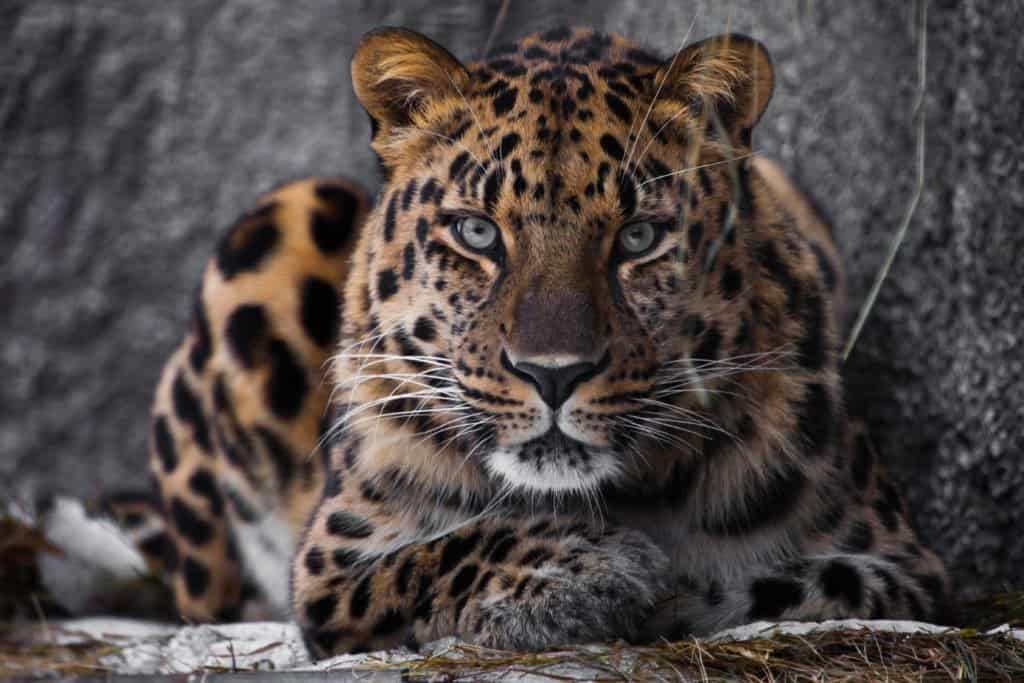
Amur leopard’s coats fade in the winter to match their surroundings.
©Mikhail Semenov/Shutterstock.com
Like all leopard subspecies, the Amur leopard is covered by ‘rosette’ markings across its coat. The coloration of leopards varies with their surrounding environment, and as the Amur leopard lives in the most northerly environment of all leopard subspecies, in winter its coat becomes paler than other subspecies. During the winter, its coat also grows about 7 cm (2.75 in) to insulate the Amur leopard from temperatures in its habitat that can reach -30 degrees Celsius (-24 F).
Male Amur leopards typically weigh 32 to 48 kg, while females weigh 25 to 43 kg. This makes the Amur leopard smaller than the African leopard subspecies on average, although The Wild Cats Conservation Alliance has recorded male Amur leopards reaching 75 kg (165 lbs).
Behavior

Amur leopards are solitary animals that hunt nocturnally.
©Warren Metcalf/Shutterstock.com
The Amur leopard is largely solitary with the exception of mothers with their offspring and adults during mating season. Like other leopard subspecies, the Amur leopard hunts nocturnally. However, camera traps have shown the species may be more active than other leopard subspecies during daylight hours.
Home range sizes vary depending on the habitat, food available, and the season. While home ranges have been observed exceeding 160 square km, the core areas where Amur leopards hunt is typically much smaller.
Habitat
Today, Amur leopards live in a small range along the Chinese-Russian border. Traditionally the subspecies ranged across Korea and upper Manchuria. However, today almost its entire population lives in Russian forests about 30 mi (48 km) to the west of the Russian port city of Vladivostok.
Temperatures in this region can top over 30 degrees Celsius (90 F) during the summer and can drop below negative 30 degrees Celsius (-24 F) during the winter, making it a more extreme environment than where other leopards live. Amur leopards are most commonly observed on camera traps in higher altitudes along the temperate forests in the hills and mountains of the region.
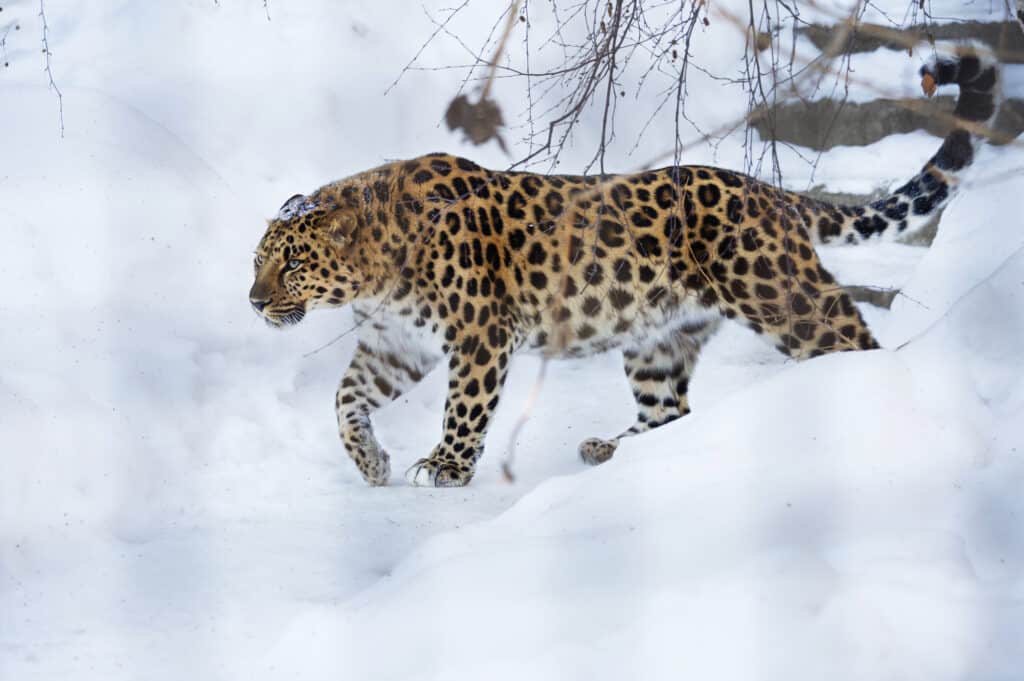
The Amur leopard can only be found wild in a small range along the Chinese-Russian border.
©iStock.com/opposable-toothed mandibles
Population — How Many Amur Leopards Are Left?
In 2000, a survey of Amur leopards found that as few as 30 individuals remained in the wild, leaving the species critically close to extinction. Since that survey, a concerted effort by conservation groups and the governments of Russia and China has helped the population rebound.
Russia created a ‘Land of the Leopard Park’ that covers 647,000 acres of leopard habitat. Today, the vast majority of leopards live within the borders of this protected habitat.
As of 2018, it is estimated that at least 103 leopards live in Russia, with a smaller number of sightings occurring across the borders of China, and North Korea.
Learn more about the most endangered species on the planet here.
Diet and Prey
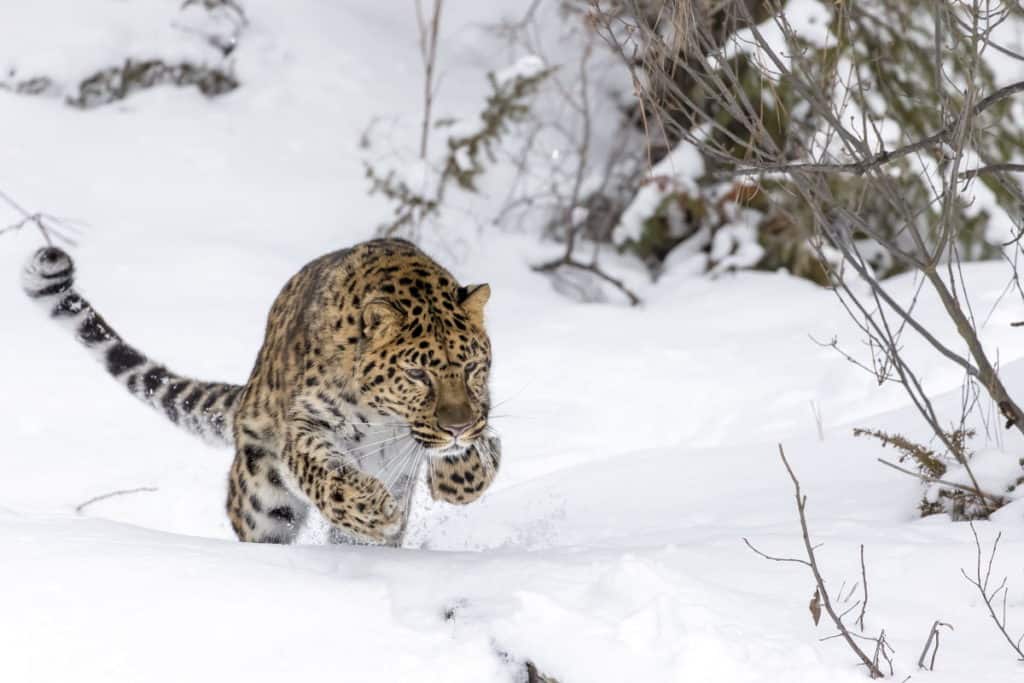
Amur leopards prey on sika deer, roe deer, and small mammals.
©Grindstone Media Group/Shutterstock.com
The Amur leopard is a carnivore that lives on a diet consisting predominately of sika deer, roe deer, and other small mammals such as squirrels, rodents, and hares. A solitary hunter, the Amur leopard ambushes its prey with bursts of energy that include tremendous leaping ability and speeds of up to 35 miles per hour (56 km/h).
Like other leopard subspecies, the Amur leopard can climb trees for rest and also protect its kills from other predators and scavengers. Due to the extreme environments, Amur leopards live in, winter proves more difficult when less prey is available and snow makes it difficult for leopards to blend in with their background. During this time, Amur leopards will expand their home range in search of more available prey.
Predators and Threats
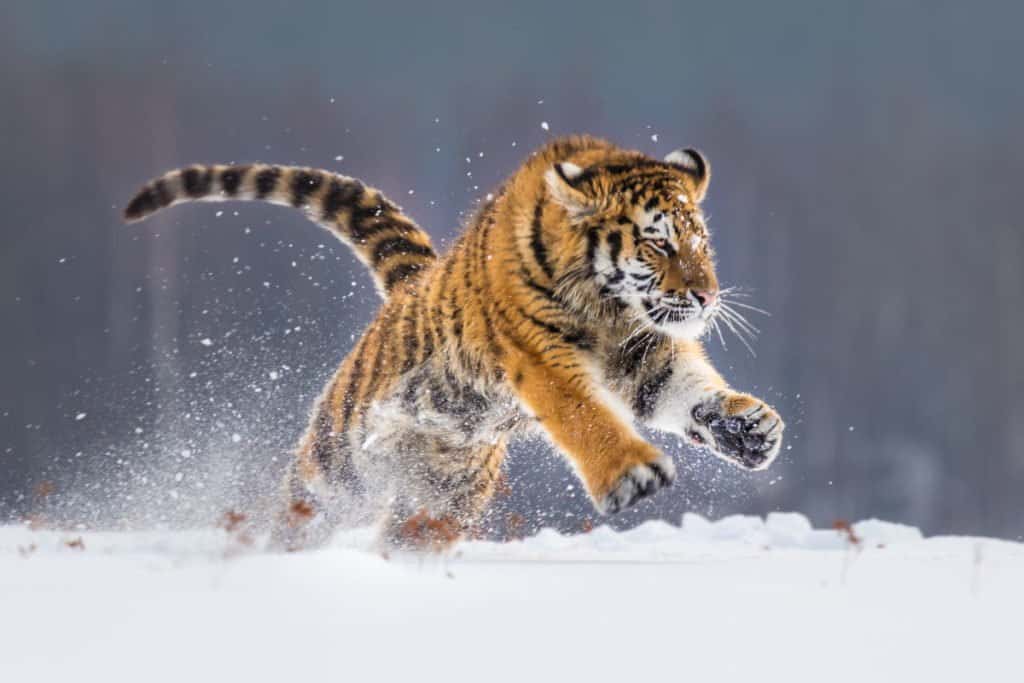
Wherever their ranges overlap – the Siberian
Tiger
preys on the Amur leopard.
©Jan Stria/Shutterstock.com
The Amur leopard faces few threats from predators, aside from humans who have hunted Amur leopards for their coats. While the Amur leopard is a top predator in their habitat, their range does overlap with the Siberian tiger.
In many regions where tiger and leopard territories overlap, leopards have struggled with the competition of another apex predator. However, researchers watching the growth of Siberian tiger populations haven’t detected an adverse effect on Amur leopards.
Reproduction and Life Cycles
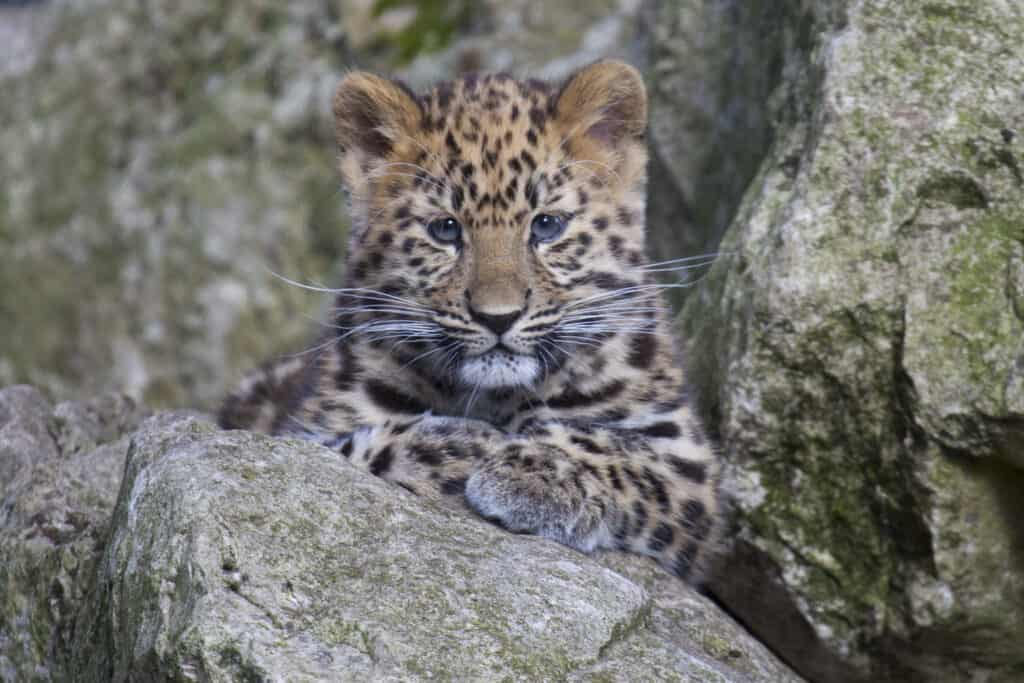
Amur leopard cubs live with their mothers for up to 24 months before establishing their own territories.
©iStock.com/AlanJeffery
Amur leopard females reach sexual maturity and can first breed at around three years of age. Gestation periods range from about 90-105 days. Litters can range between 1 to 6 cubs, although 2 to 3 cubs are the most common litter size.
Due to the extreme conditions Amur leopards live in, it takes longer to raise an adolescent to independence than the leopard subspecies in Africa. Cubs may live with their mother for up to 24 months before establishing their own territory.
Zoos Are a Good Place to See Amur Leopards
While the remaining population of Amur leopards in the wild remains critically low, approximately 300 survive in zoos across the world.
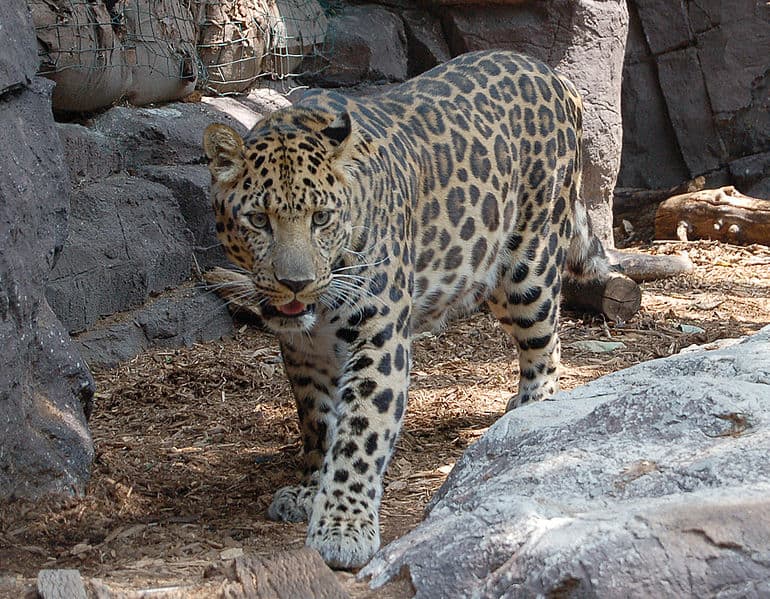
Amur Leopard at Philadelphia Zoo
©Derek Ramsey (Ram-Man), CC BY-SA 2.5, via Wikimedia Commons – Original / License
Select zoos where you can see the Amur leopard in person:
- Beardsley Zoo(Bridgeport, Connecticut): Welcomed two new Amur leopard cubs in March 2019.
- Minnesota Zoo: Located in the zoo’s “Russia’s Grizzly Coast” section.
- Santa Barbara Zoo: Home to two Amur leopards, Ajax and Wyatt.
- Hogle Zoo (Salt Lake City, Utah): Home to Zaya and her calf Jilin, who was born In May 2018.
- Denver Zoo: I first arrived at the zoo in 1989!
Interesting Amur Leopard Facts
A tunnel to help save the Amur leopard?
- In 2016 Russia completed a 575 meter (1,886 ft) tunnel to divert traffic from an area where remaining Amur leopard populations remained. Russia and China have cooperated on protecting the remaining Amur leopard populations. While the Chinese side of the border is more densely populated, the Russian habitat is largely uninhabited. Which has helped the species rebound.
The Amur leopard has tiny hooks on its tongue!
- The amur leopard has “denticles” or tiny hooks on its tongue. These hooks allow the leopard to lick the bones of its prey and collect even more meat.
New habitat reintroduction could be in the Amur leopards’ future
- While the wild population of Amur leopards has rebounded to more than 100 individuals as of 2018, the population in captivity remains far larger. Special environments such as Scotland’s Highland Wildlife Park have built specialized Amur leopard habitats with the goal of creating populations that can be reintroduced into the wild. The reintroduction of captive Amur leopards could increase the size of their habitat and continue increasing genetic diversity from today’s levels.
Amur Leopard FAQs (Frequently Asked Questions)
Why is the Amur leopard endangered?
The Amur leopard is endangered predominately because of poaching for its coat and habitat loss. The species once ranged across the Korean peninsula, but is believed to have gone extinct there in the 1960s. Today Amur leopards are protected by anti-poaching laws and have protected habitat, but need to see its populations continue rebounding to escape threats posed by inbreeding and potentially devastating diseases.
Where do Amur leopards live today?
The Amur leopard lives in a small area in Russia’s Far East that’s roughly 7,000 square kilometers on the Russia and China border. Today, the vast majority of the population lives in a protected area in Russia named ‘Land of the Leopard Park,” although a small number of Amur leopards have been seen inside China’s side of the boarder.
What is being done to save the Amur leopard?
Russia has established a ‘Land of the Leopard Park’ with the aid of conservation groups. This park has been critical in seeing the population of Amur leopards more than triple between 2000 and 2018. In the future, Amur leopards from captivity could be released into the wild to continue expanding the species territory and helping the species survive threats like inbreeding from its limited population.
Are Amur Leopards herbivores, carnivores, or omnivores?
Amur Leopards are Carnivores, meaning they eat other animals.
What Kingdom do Amur Leopards belong to?
Amur Leopards belong to the Kingdom Animalia.
What phylum do Amur Leopards belong to?
Amur Leopards belong to the phylum Chordata.
What class do Amur Leopards belong to?
Amur Leopards belong to the class Mammalia.
What family do Amur Leopards belong to?
Amur Leopards belong to the family Felidae.
What order do Amur Leopards belong to?
Amur Leopards belong to the order Carnivora.
What type of covering do Amur Leopards have?
Amur Leopards are covered in Hair.
What are some predators of Amur Leopards?
Predators of Amur Leopards include humans and Siberian tigers.
How many babies do Amur Leopards have?
The average number of babies an Amur Leopard has is 2-3.
What is an interesting fact about Amur Leopards?
The Amur leopard may be the rarest big cat on Earth!
What is the scientific name for the Amur Leopard?
The scientific name for the Amur Leopard is Panthera pardus orientalis.
What is the lifespan of an Amur Leopard?
Amur Leopards can live for 10 to 15 years in wild and up to 20 years in captivity.
How many Amur Leopards are left in the world?
There were 103 Amur Leopards left in the world in 2018.
Thank you for reading! Have some feedback for us? Contact the AZ Animals editorial team.
Sources
- David Burnie, Dorling Kindersley (2011) Animal, The Definitive Visual Guide To The World's Wildlife / Accessed January 2, 2020
- Tom Jackson, Lorenz Books (2007) The World Encyclopedia Of Animals / Accessed January 2, 2020
- David Burnie, Kingfisher (2011) The Kingfisher Animal Encyclopedia / Accessed January 2, 2020
- Richard Mackay, University of California Press (2009) The Atlas Of Endangered Species / Accessed January 2, 2020
- David Burnie, Dorling Kindersley (2008) Illustrated Encyclopedia Of Animals / Accessed January 2, 2020
- Dorling Kindersley (2006) Dorling Kindersley Encyclopedia Of Animals / Accessed January 2, 2020
- David W. Macdonald, Oxford University Press (2010) The Encyclopedia Of Mammals / Accessed January 2, 2020


















